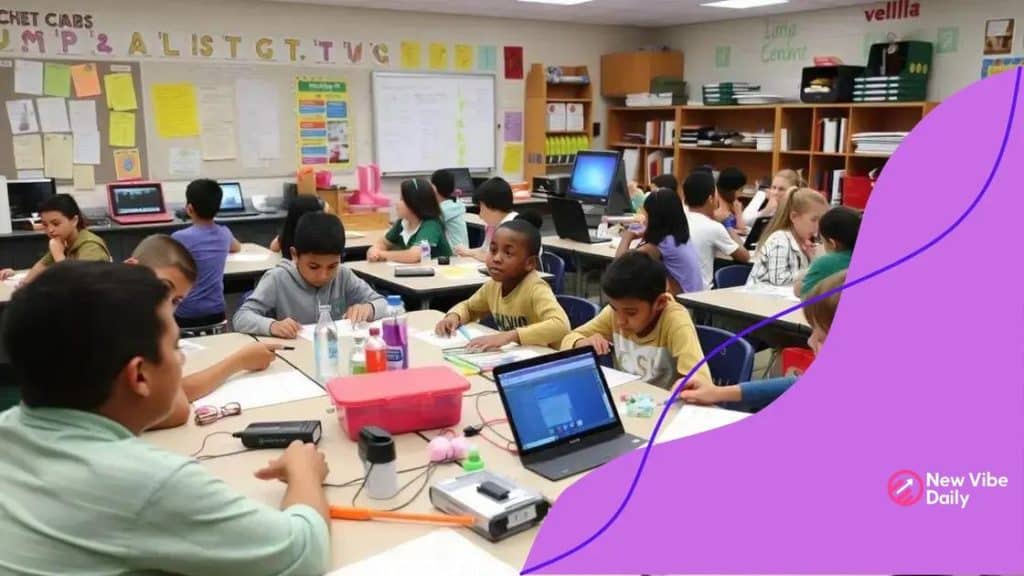STEM education funding: how to secure resources

Evaluating the impact of funded STEM initiatives is essential to ensure their effectiveness, involving clear goal-setting, data collection, and community engagement to continuously improve educational outcomes.
STEM education funding plays a vital role in providing resources for essential programs that inspire students. But how can schools and educators secure these funds? In this article, we’ll dive into effective strategies that can make a difference.
Understanding the importance of STEM education
Understanding the importance of STEM education is crucial for both students and society. STEM, which stands for Science, Technology, Engineering, and Mathematics, provides students with essential skills needed in today’s job market.
Why STEM is Important
STEM education encourages students to think critically and solve complex problems. This prepares them for future careers in high-demand fields. Additionally, it fosters innovation and creativity, which are vital for economic growth.
Benefits of STEM
Through STEM education, students gain hands-on experience which enhances their understanding and retention of knowledge. Here are some key benefits:
- Develops analytical skills
- Enhances teamwork and collaboration
- Improves communication abilities
- Encourages real-world applications of knowledge
Moreover, the integration of technology in STEM lessons captivates students’ attention and makes learning engaging. This active involvement helps them grasp complex concepts more easily.
In today’s fast-paced world, STEM education lays the groundwork for future success. With a strong foundation in these areas, students are better equipped to tackle challenges and seize opportunities as they arise. Supporting this type of education is essential for the advancement of society and the economy.
Key sources of funding for STEM programs
Identifying key sources of funding for STEM programs can greatly enhance educational opportunities for students. Schools and educators need to explore various avenues to secure these essential resources.
Government Grants
Many government agencies provide grants specifically aimed at supporting STEM education. These can be federal, state, or local funds designed to improve facilities, technology, and curriculum.
- National Science Foundation (NSF) grants
- Department of Education funding initiatives
- State-level educational improvement grants
Each of these sources has specific requirements and application processes that need to be followed closely.
Corporate Sponsorships
Companies often seek to invest in STEM programs to promote education and innovation in their fields. Partnering with local businesses can result in valuable resources and financial support.
- Tech companies offering equipment donations
- Financial sponsorships for events and competitions
- Internship programs funded by corporations
These partnerships not only assist schools but also help companies build a positive reputation while fostering future talent.
Another important source of funding is private foundations and nonprofit organizations that focus on education. Many of these organizations provide grants and resources aimed at specific STEM initiatives. Schools can benefit significantly from these partnerships.
Having a well-rounded approach to identifying funding sources is essential. By tapping into various avenues—such as grants, corporate sponsorships, and private foundations—educators can create robust STEM programs that benefit all students.
How to write successful grant proposals

Writing successful grant proposals is essential for securing funding for STEM programs. A well-crafted proposal can make a significant difference in funding outcomes.
Understanding the Requirements
Before writing, it’s crucial to understand the specific requirements of each grant. This ensures that your proposal aligns with the funder’s priorities and expectations. Take time to research the organization offering the grant and tailor your proposal accordingly.
- Read the grant guidelines carefully.
- Note eligibility criteria.
- Identify required documents.
- Pay attention to deadlines.
Each grant has unique goals, and aligning your project with these goals is key to success.
Crafting a Strong Narrative
The core of your proposal should tell a compelling and clear story. Start by outlining your project goals, explaining why they matter in the context of STEM education. Describe the target audience and the anticipated impact, making sure to support your claims with data and research.
Be clear and concise while emphasizing the value of your project. Use engaging language, and don’t shy away from showing your passion for STEM education. This personal touch can resonate with reviewers.
Furthermore, it’s important to establish a detailed budget. This budget should outline how funds will be used, ensuring it aligns with project goals. Be transparent about costs and include justification for each item. This demonstrates careful planning and responsibility.
Another essential part of the proposal is a clear timeline. A well-structured timeline shows that you have a realistic plan for completing the project and achieving its goals. Make sure to highlight key milestones to track progress effectively.
Finally, before submitting your proposal, seek feedback from peers or mentors. Their input can provide valuable perspectives and help improve the overall quality of your submission.
Understanding these key elements can significantly increase your chances of writing successful grant proposals. Each step is critical in presenting a strong case for funding your STEM program.
Engaging the community for support
Engaging the community for support is a vital strategy in enhancing STEM education. Building strong connections with local organizations, businesses, and families can provide essential resources and backing for educational programs.
Building Partnerships
Establishing partnerships with local businesses and community organizations can amplify the impact of STEM programs. These collaborations can lead to funding, volunteering, and valuable resources. It’s essential to identify potential partners whose missions align with your educational goals.
- Local businesses can provide financial support or materials.
- Nonprofit organizations might offer mentorship programs.
- Colleges and universities may supply expertise and resources.
- Community groups can help mobilize volunteers and resources.
Creating a mutual benefit plan is crucial. Show partners how supporting your program will benefit them as well, such as through positive community visibility and potential workforce development.
Hosting Community Events
Organizing events, such as workshops or science fairs, can effectively engage the community and showcase the importance of STEM education. These events allow community members to see firsthand the value of STEM initiatives. Inviting families to participate fosters a sense of ownership and encourages their support.
Additionally, consider launching outreach campaigns that highlight the success of your STEM programs. Share stories of students who have benefitted from community support. Utilize social media platforms to reach a wider audience and create a buzz around your programs.
Involving students in community activities also helps to make the connection stronger. When students participate in community service or project shows, they gain valuable experience while also representing their school and its programs.
Support from the community is not just beneficial; it’s crucial for the sustainability of STEM education. By fostering these relationships, educators can create a solid foundation that enhances learning opportunities and strengthens community ties.
Evaluating the impact of funded STEM initiatives
Evaluating the impact of funded STEM initiatives is crucial to understanding their effectiveness. By assessing these programs, educators and stakeholders can determine what works and what needs improvement.
Setting Clear Goals
To evaluate any STEM initiative, it’s important to start with clear goals. Define what success looks like for your program. Is it improved student performance in STEM subjects? Increased interest in STEM careers? Identifying these goals helps in crafting a focused evaluation.
- Establish specific, measurable outcomes.
- Determine the timeframe for evaluation.
- Involve stakeholders in the goal-setting process.
This collaboration ensures that everyone agrees on what the initiative should achieve.
Collecting Data
Once goals are set, the next step is collecting data. Use various methods to gather information on the initiative’s performance. Surveys, interviews, and standardized tests provide quantitative and qualitative data.
Engaging students and teachers in the evaluation process yields valuable insights. Their feedback can highlight strengths and weaknesses, helping adjust strategies effectively. It’s also helpful to compare the results with previous performance metrics to see tangible progress.
In addition to direct feedback, tracking participation in STEM programs can reveal levels of engagement. High participation rates often correlate with positive outcomes, indicating that students are connecting with the material.
Analyzing Results
Once data is collected, analyze it with a focus on the established goals. Look for patterns and trends. For instance, did student test scores improve after implementing a new STEM initiative? Did more students pursue advanced STEM courses as a result of the program?
Consider conducting focus groups or interviews with participants to understand their experiences better. This qualitative data complements the quantitative findings and provides a fuller picture of the initiative’s impact.
Ultimately, the goal of evaluating STEM initiatives is to improve future programs. Understanding what worked allows educators to replicate success and reassess strategies that fell short. This continuous improvement cycle strengthens STEM education for all students.
FAQ – Questions about Evaluating the Impact of Funded STEM Initiatives
Why is evaluating STEM initiatives important?
Evaluating STEM initiatives helps determine their effectiveness, ensuring resources are used efficiently and goals are met.
What methods can be used for data collection?
You can use surveys, interviews, and performance assessments to collect data on the initiative’s impact.
How can community involvement enhance STEM initiatives?
Community involvement can provide additional resources, support, and engagement, increasing the program’s chances of success.
What should be included when setting goals for STEM programs?
Goals should be specific, measurable, and aligned with the desired outcomes for student performance and engagement.






